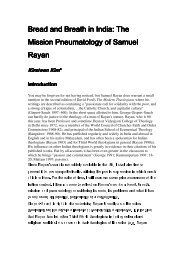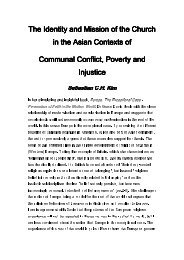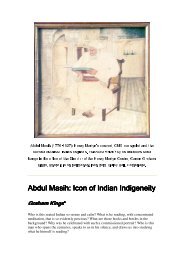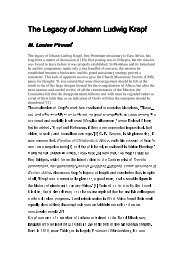The Drum, the Church, and the Camera - Henry Martyn Centre
The Drum, the Church, and the Camera - Henry Martyn Centre
The Drum, the Church, and the Camera - Henry Martyn Centre
- No tags were found...
Create successful ePaper yourself
Turn your PDF publications into a flip-book with our unique Google optimized e-Paper software.
Mr. C. W. Hattersley. <strong>The</strong> most striking of <strong>the</strong>se, reproduced here below, combines exotic <strong>and</strong> Christian elements in such a way that it can be said to encapsulate <strong>the</strong> Bag<strong>and</strong>a story. An unknown youth, wearing a white garment, st<strong>and</strong>s in Namirembe Ca<strong>the</strong>dral, Kampala, a church designed by Europeans for an African context <strong>and</strong> built by Africans. He st<strong>and</strong>s on a missionary,beating a large drum. Near him is a notice, or reading sheet, a reminder of <strong>the</strong> Bag<strong>and</strong>a passion for literacy, which almost overwhelmed <strong>the</strong> missionaries. To <strong>the</strong> European observer, unfamiliar with East Africa, <strong>the</strong> young man's apparel suggests an ecclesial surplice. Subliminally perhaps it suggests <strong>the</strong> white robes of <strong>the</strong> newly baptized of early church tradition. It is, platform,fact a kanzu. This garment was introduced by <strong>the</strong> Arabs <strong>and</strong>, despite its Islamic associations, was favored by missionaries as <strong>the</strong> most suitable garb for converts, preferable to both <strong>the</strong> native bark cloth, which was inunhygienic, <strong>and</strong> to European clothing. "Nothing", said Bishop Alfred Tucker, "could be more seemly".[2] considered
drum does not feature in most published accounts of <strong>the</strong> building <strong>and</strong> consecration of ca<strong>the</strong>dral. J. D. Mullins tells us, "<strong>The</strong> Rev. <strong>Henry</strong> Wright Duta has given <strong>the</strong> Ca<strong>the</strong>dral a huge drum, 5 ft. high, whose booming sound carries immense distance. <strong>The</strong> drum not only effective as a church bell, but far more in keeping with national customs".[3] <strong>The</strong>Wright Duta (d. 1913) was one <strong>the</strong> first Bag<strong>and</strong>a converts, baptized at Zanzibar in 1882. Narrowly escaping martyrdom in 1885, he survived to be commissioned as a lay evangelist by Tucker in 1891. He was ordained deacon in 1893, one of <strong>the</strong> first group of native clergy, <strong>and</strong> priest 1896. He was George L. Pilkington's chief assistant in his translation work <strong>and</strong> played a <strong>Henry</strong>part in <strong>the</strong> production of <strong>the</strong> Lug<strong>and</strong>a Bible.[4] major
court, where human life was held cheap, <strong>and</strong> that <strong>the</strong>y usually contained fetishes, it seems surprising that <strong>the</strong> missionaries <strong>and</strong> converts were willing to countenance <strong>the</strong>ir use in Christian contexts. It not clear from <strong>the</strong> sources<strong>the</strong> new use of drums arose because of Bag<strong>and</strong>a pressure or whe<strong>the</strong>r because of deliberate missionary adoption. royal years drums lost much of <strong>the</strong>ir importance. Allan J. Lush, writing in 1935, reports that although drums were still used, <strong>the</strong> majority of young Bag<strong>and</strong>a were ignorant about <strong>the</strong>ir names <strong>and</strong> history. He attributes this to <strong>the</strong> end of despotic rule <strong>and</strong> <strong>the</strong> adoption of Western ideas.[6] <strong>Henry</strong> Wright Duta's drum, re-covered more than once, is still kept in <strong>the</strong> drum-house at Over<strong>and</strong> used on special occasions. It is not normally used to summon people to church; that is done, Western-style, by bell.[7] Namirembelongs know about drum. it specially <strong>the</strong><strong>Drum</strong>s played a great part in <strong>the</strong> life of <strong>the</strong> pre-Christian Bag<strong>and</strong>a <strong>and</strong> gave manyproverbs <strong>and</strong> idioms to <strong>the</strong>ir language. A large number of named drums groups ofdrums, with <strong>the</strong>ir own drumbeats <strong>and</strong> designated drummers, were associated with <strong>the</strong>ritual of court of <strong>the</strong> Bag<strong>and</strong>a king. For example, when <strong>the</strong> Kabaka ("king")presented a chief with any office, would give him a drum, <strong>and</strong> <strong>the</strong> man so investedwould said to have "eaten" <strong>the</strong> drum. O<strong>the</strong>r drums were associated with lesserchiefs, clans, <strong>and</strong> local shrines. Apart from <strong>the</strong>se special drums, any individual mightown one. <strong>Drum</strong>s were widely used to accompany singing <strong>and</strong> dancing <strong>and</strong> toannounce news. In <strong>the</strong> words of John Roscoe, <strong>the</strong> drum "had its place in <strong>the</strong> mostsolemn <strong>and</strong> in <strong>the</strong> most joyous ceremonies of <strong>the</strong> nation". <strong>The</strong> Namirembe Ca<strong>the</strong>draldrum is reminiscent of <strong>the</strong> royal drums described by Roscoe:Ug<strong>and</strong>aPre-Christian used? been it had purposes what for latter, <strong>the</strong> If past? pre-Christian a have it did or ca<strong>the</strong>dral, for made Was <strong>the</strong> more to One<strong>The</strong> drums were made from hollowed-out tree trunks encased incowhide; only one end of <strong>the</strong> drum was beaten upon, <strong>and</strong> that wasalways kept uppermost. Some of <strong>the</strong> drums were beautifully decoratedwith cowry-shells or beads. It was <strong>the</strong> rule to suspend <strong>the</strong>m on postsslightly raised from <strong>the</strong> ground so as to get <strong>the</strong> full benefit of <strong>the</strong>sound, <strong>and</strong> <strong>the</strong> man stood over <strong>the</strong> drum with two short sticks forbeating it.[5]that drums were so closely linked to traditional shrines <strong>and</strong> <strong>the</strong> life of a Given
<strong>The</strong> things of <strong>the</strong> Europeans are always amazing; <strong>and</strong> I thought tomyself that if we were always wondering at <strong>the</strong>se things which we sawwhile we were still on <strong>the</strong> way we should be like <strong>the</strong> Apostle of ourLord who was called St. John <strong>the</strong> Evangelist, who when he saw <strong>the</strong>wonders of God, which he had never seen before; <strong>and</strong> when he wrote<strong>the</strong>m down in his book he had just to compare <strong>the</strong>m to <strong>the</strong> earthlythings <strong>the</strong>y knew, though <strong>the</strong>y were not really like <strong>the</strong>m.[8]Ug<strong>and</strong>a's Katikiro in Engl<strong>and</strong> <strong>the</strong> photograph is used to illustrate a particular point in Mukasas text. One of his recurring <strong>the</strong>mes admiration of <strong>the</strong> technological feats of <strong>the</strong> British, "<strong>the</strong> cleverness of English which is never-ending", <strong>and</strong> he struggles to describe <strong>the</strong>se wonders in ways intelligible to his fellow Bag<strong>and</strong>a. He uses a biblical analogy to describe his difficulty. InLet me tell you about it. Its height is twice as great as that of SilasiMugwanya's house…. With what can you compare a seven-storiesship? It is as wide as Ham Mukasa's brick house... <strong>the</strong> masts are as biground as <strong>the</strong> Katikiro's drum... <strong>the</strong> length is one <strong>and</strong> a half times that ofNamirembe Ca<strong>the</strong>dral, <strong>the</strong> great tube out of which <strong>the</strong> smoke comes isas large or larger than <strong>the</strong> largest drum in Namirembe Ca<strong>the</strong>dral.[9]unlike <strong>the</strong> apostle, Mukasa could call photography to his aid. <strong>The</strong> first marvel he encountered was <strong>the</strong> steamer that took <strong>the</strong> Katikiro's party from Mombasa to Aden: However,Backing <strong>the</strong> opposite page in Millar's edition is <strong>the</strong> photograph that is reproducedhere, with Mukasa's comparison to <strong>the</strong> drum as caption.He took many photographs of our country <strong>and</strong> of different kinds ofpeople, peasants <strong>and</strong> chiefs <strong>and</strong> of <strong>the</strong> king <strong>and</strong> of <strong>the</strong> old kind ofhouses which are being done away with at <strong>the</strong> present time <strong>and</strong> of ourdifferent styles of clothing.... After dinner he showed us a great manyphotographs from Ug<strong>and</strong>a <strong>and</strong> <strong>the</strong> neighbouring countries.[10]are accustomed to <strong>the</strong> idea that missionary supporters in Engl<strong>and</strong> were fascinated <strong>and</strong> influenced by visual images from <strong>the</strong> mission field. It is less usual to be able observe <strong>the</strong> reactions of Africans to <strong>the</strong>se images. Mukasa describes a visit Herbert Samuel in London: WeLater Mukasa visited <strong>the</strong> Millars, <strong>and</strong> "Mr. Millar showed us a great manyphotographs of people in our country".[11]Katikiro <strong>and</strong> Mukasa obviously relished <strong>the</strong> many opportunities to have <strong>the</strong>ir own photographs taken. <strong>The</strong>y were photographed with British army <strong>The</strong>
<strong>The</strong>y register <strong>the</strong> prisoners very cleverly; <strong>the</strong>y first take photographs of<strong>the</strong>m <strong>and</strong> <strong>the</strong>n write down <strong>the</strong> height of each man <strong>and</strong> <strong>the</strong> size of hischest, <strong>and</strong> his colour, <strong>and</strong> his offense, <strong>and</strong> <strong>the</strong> length of hisimprisonment, <strong>and</strong> <strong>the</strong> place he comes from <strong>and</strong> his name <strong>and</strong> religion.All this <strong>the</strong>y do to remind <strong>the</strong>mselves about each man, so that when hecommits ano<strong>the</strong>r offense it is always known what he is like in everyrespect. I thoroughly approved of this, because it teaches us a spirituallesson. If we men have <strong>the</strong> wisdom to mark criminals who offendagainst our human laws, how will it be with <strong>the</strong> creator of heaven <strong>and</strong>earth?[16]in Bug<strong>and</strong>a, <strong>the</strong> travelers were besieged by people wanting to hear Back<strong>and</strong> at <strong>the</strong> headquarters of <strong>the</strong> Mill Hill Fa<strong>the</strong>rs.[13] Photographs were taken at <strong>the</strong> door of <strong>the</strong> Houses of Parliament[14] <strong>and</strong> Crewe with a railway engine.[15] On <strong>the</strong> return journey Ug<strong>and</strong>a, Mukasa had fur<strong>the</strong>r opportunities indulge his passion for photographs. On a visit Mombasa prison, Mukasa was particularly struck by of <strong>the</strong> prisoners "which officers[12]very well taken". He went to commend <strong>the</strong> prison administration's use of photography: were<strong>the</strong>ir "We no by or some went <strong>the</strong> o<strong>the</strong>rs to all very to all Engl<strong>and</strong>; I <strong>the</strong>m... photographs had taken us we in <strong>and</strong> pictures coronation."[17] would good know <strong>the</strong>se survive. while may about experiences. had rest day night; peopleCharles William Hattersley (1866-1934),to Katikiro, came me, wanting muchdespitelearn<strong>the</strong>aboutinfluence of his books <strong>and</strong>photographs<strong>and</strong><strong>and</strong>showedhis majorwhichrolebeeninof<strong>the</strong>whiledevelopmentwereofEngl<strong>and</strong>education inofUg<strong>and</strong>a,kingsisItnot awell-known figure. Accepted by <strong>the</strong> CMS in February 1897, was previouslymanager of a cutlery works in Sheffield.[18] He left for Ug<strong>and</strong>a in September, <strong>and</strong> hismissionary career had a tragic beginning. On <strong>the</strong> way up from <strong>the</strong> coast, Hattersley'srifle misfired, shooting his colleague E. H. Hubbard in <strong>the</strong> back. Despite all <strong>the</strong> effortsof Dr. Albert Cook, Hubbard died at Mengo a few weeks later. No blame seems tohave been laid on Hattersley, <strong>and</strong> his name was suppressed in <strong>the</strong> published reports ofHubbard's death.[19] Hattersley's initial duties were assist Archdeacon RobertWalker "in <strong>the</strong> business part of <strong>the</strong> work," keeping accounts, supervising <strong>the</strong> stores<strong>and</strong> <strong>the</strong> sale of books. Bishop Tucker, having asked Hattersley implement a systemPhotographer Missionary <strong>the</strong> instead. used he that Hattersley about doubt no is <strong>the</strong>re public, British <strong>the</strong> regret we But if to be Hattersley by photographs of interest quality <strong>the</strong> with share not did Millar that
give glimpses of <strong>the</strong>ir domestic life with <strong>the</strong>ir infant son Stanley, named for <strong>the</strong> explorer who first invited missionaries to Bug<strong>and</strong>a. Stanley kept an interest in <strong>the</strong> progress of <strong>the</strong> <strong>and</strong> corresponded with Hattersley. A photograph, captioned "Black <strong>and</strong> White: A Little Negro Boy <strong>and</strong> <strong>the</strong> Son of <strong>the</strong> Author," shows <strong>the</strong> two children looking what could be a photograph HomeHattersley labors his point: "Our picture little white boy with his native playmate affords good illustration of <strong>the</strong> safety in which people exist at <strong>the</strong> moment. Ladies <strong>and</strong> children live in almost perfect security amongst a people who a few years back were in a state of anarchy, bloodshed, war raiding, slavery, distress <strong>and</strong> poverty."[21] album.1904 Hattersley's sister Emily, a clerk in <strong>the</strong> furnishing business, followed him to Ug<strong>and</strong>a <strong>and</strong> worked as a teacher until her resignation 1911.[22] Hattersley himself resigned from CMS in 1913 because of a conflict of interest Inof primary education, writes that he took <strong>the</strong> task in h<strong>and</strong> with characteristic energy.(Everyone who wrote about Hattersley commented on his energy.) Later his interestsmoved from general primary education to <strong>the</strong> education of sons of <strong>the</strong> chiefs <strong>and</strong> <strong>the</strong>future elite, <strong>and</strong> he became <strong>the</strong> founding headmaster of Mengo.[20]in Engl<strong>and</strong> in 1902-3, Hattersley married Florence Annie Middleton, who accompanied him back to Ug<strong>and</strong>a. Photographs published in <strong>The</strong> Bag<strong>and</strong>a at BackBy half past three in <strong>the</strong> morning <strong>the</strong> king's drums were booming <strong>the</strong>signal for assembling. I had been asked on this occasion to go up early<strong>and</strong> take a photograph <strong>and</strong> had thought that early might perhaps meanseven or eight o'clock. Before six however a special messenger from<strong>the</strong> Katikiro arrived on a bicycle to say that if I wished to have awas by now a manager of <strong>the</strong> Planters Company) <strong>and</strong> differences of opinion about <strong>the</strong> teaching at Mengo Boys School. After some years, he returned to Engl<strong>and</strong> <strong>and</strong> went into business London. <strong>The</strong> business failed in <strong>the</strong> depression, tormented by his inability, as he saw it, to provide for his family, Hattersley took his own life.[23] (hehappier days, <strong>the</strong>re was no doubt of Hattersley's devotion to photographic duty. In 1907 boy-king of Ug<strong>and</strong>a, Daudi Chwa, paid an official visit <strong>the</strong> tomb of his gr<strong>and</strong>fa<strong>the</strong>r Mutesa. Here he was to participate in a cleaned-up, Christianized version of a ritual that had previously involved pagan rites <strong>and</strong> human sacrifice. <strong>The</strong> prime minister, Apolo Kagwa, invited Hattersley to In ceremonies. Hattersley recalls, photograph
to <strong>the</strong> church <strong>and</strong> court of Ug<strong>and</strong>a. Prints circulated among his fellow missionaries, who <strong>the</strong>n used <strong>the</strong>m to illustrate <strong>the</strong>ir own books.[25] <strong>The</strong> print of <strong>the</strong> Namirembe Ca<strong>the</strong>dral drum reproduced here comes from <strong>the</strong> Ernest Millar collection in Royal Commonwealth Society Collections, Cambridge University Library (Y045L).[26] O<strong>the</strong>r Hattersley prints are found in photographeralbum of of Ug<strong>and</strong>a ca. 1906-11 (Y3045C), which also contains photographs by <strong>the</strong> commercial photographer Alfred Lobo <strong>and</strong> by Protectorate officials. Many of <strong>the</strong>se are reproduced in Hattersley's published works. An album belonging to Archdeacon Walker, currently in possession of Walker's great-nephew, contains examples of his work, <strong>and</strong> <strong>the</strong> Hattersley anhas photographs of <strong>the</strong> Hattersley children <strong>and</strong> scenes in Ug<strong>and</strong>a that I have not seen reproduced elsewhere. Hattersley's own books are profusely illustrated with photographs; Ug<strong>and</strong>a by family<strong>and</strong> <strong>Camera</strong> nearly thirty plates;[27] <strong>The</strong> Bag<strong>and</strong>a at Home has "one hundred pictures of life <strong>and</strong> work in Ug<strong>and</strong>a". Even <strong>the</strong> thirty-six page Erastus, Slave <strong>and</strong> Prince has thirteen photographs.[28] This tract tells <strong>the</strong> story of Penphotograph I must hurry up because <strong>the</strong> work was all butcompleted.[24]by dint of his own enthusiasm, had assumed <strong>the</strong> role of official Hattersley,Kalamagi, <strong>the</strong> chiefly enslaved a converted, restored his as adult, to his in conversion his <strong>The</strong> in work particularly<strong>the</strong>y three "Slave catching by <strong>the</strong> glare of burning huts seen in <strong>the</strong> background"; "Slave raider <strong>and</strong> captive"; ErastusUg<strong>and</strong>afrombyMunyoroPenfamily,<strong>and</strong>as<strong>Camera</strong>child,is,that must have been posed <strong>and</strong> set freed,astoitsfamilytitleanpagereadydeclares,play"profusely illustrated<strong>the</strong>fromofphotographs".people.Itphotographs thisaarecallinteresting thatprayerinclude<strong>and</strong>-missionaryraiderrecruits,boys<strong>and</strong>night:<strong>the</strong> prose, whichoscillates between pedestrian <strong>and</strong> <strong>the</strong> evocative, suggests origins in illustratedtalk or talks. <strong>The</strong> quality of reproduction is unfortunately poor, but <strong>the</strong> photographsnot just an added extra. Hattersley makes valiant attempts to integrate text <strong>and</strong>Photographs of Use Promotional skill. without up, - household" a surprising raiders "Slave
as missionary propag<strong>and</strong>ist - a distinction he would have seen as meaningless. His camera pressed into service both accounts. In <strong>the</strong> first chapter, "Changes in King <strong>and</strong> Court", he describes King Mutesa's practice of preserving royal umbilical cords <strong>and</strong> announces with some pride, "<strong>The</strong> photographs which are here reproduced are <strong>the</strong> only ones that have ever welltaken of <strong>the</strong>se objects."[29] Chapters entitled "<strong>The</strong> L<strong>and</strong> <strong>and</strong> Its Products" <strong>and</strong> "How <strong>the</strong> People Live" <strong>and</strong> harrowing description of <strong>the</strong> ravages of sleeping sickness follow, as well as more missionary-oriented <strong>and</strong> occasionally opinionated chapters religion education. <strong>The</strong> short final chapter, "Look on <strong>the</strong> Fields," is a missionary clarion call in which Hattersley been spiritual darkness of <strong>the</strong> non-Bug<strong>and</strong>a peoples of <strong>the</strong> Protectorate. "We have in our possession a very recent photograph of a wizard <strong>and</strong> <strong>the</strong>re is no secrecy whatever about his methods."[30] emphasizesthis photographic evidence is not reproduced. It is tempting to think that Ham Mukasa learned his appreciation of photographs from <strong>the</strong> indefatigable Hattersley, although <strong>the</strong>re is no direct evidence such a conclusion. Hattersley took photographs of <strong>the</strong> Mukasa family, several of which are <strong>the</strong> Millar collection. Certainly, Mukasa held Unfortunately,in high esteem, <strong>and</strong> his visit to <strong>the</strong> family in Sheffieldone of <strong>the</strong> highlights of his visit to Engl<strong>and</strong>. On <strong>the</strong>ir return journey <strong>and</strong> <strong>the</strong> Katikiro made a point of inquiring after Hattersley at Aden because <strong>the</strong>y had heard news of his illness. <strong>The</strong>y were much relieved to learn that he was recovering.[31] Hattersleywas away from Ug<strong>and</strong>a between July 1902 <strong>and</strong> July 1903, so seems unlikely that <strong>the</strong> photograph of <strong>the</strong> ca<strong>the</strong>dral drum was taken specifically to illustrate Mukasa's account. However, its careful composition Hattersleylighting suggest that was specially posed <strong>and</strong> set up. It is no casual shot. Hattersley took many photographs of <strong>the</strong> ca<strong>the</strong>dral. Some are reproduced in Ug<strong>and</strong>a by Pen <strong>and</strong> <strong>Camera</strong> <strong>and</strong> <strong>The</strong> Bag<strong>and</strong>a at Home, <strong>and</strong> like o<strong>the</strong>r missionaries writing for his home supporters, he made a great deal <strong>and</strong>photographs, using text to explain <strong>the</strong> photographs, <strong>and</strong> photographs to emphasize hispoints.quality of reproduction is much higher in <strong>The</strong> Bag<strong>and</strong>a at Home. Hattersley reveals himself as a perceptive, if untrained, field anthropologist as <strong>The</strong>
<strong>the</strong> dramatic story of <strong>the</strong> rise <strong>and</strong> fall (all too literal) of <strong>the</strong> successive structures at Namirembe. All accounts stressed <strong>the</strong> sacrificial giving <strong>and</strong> practical labor of <strong>the</strong> native Christians.[32] Hattersley was also assiduous in recording both pre-Christian <strong>and</strong> Christian use of <strong>the</strong> drum. Ug<strong>and</strong>a by Pen <strong>Camera</strong> reproduces a of ofinstruments - magic w<strong>and</strong>s, horns <strong>and</strong> drums." This photograph in <strong>the</strong> Millar Collection (Y3045L23), where it is captioned "Charms etc. brought to Engl<strong>and</strong> by <strong>the</strong> Katikiro <strong>and</strong> <strong>the</strong> Rev. E. Millar." <strong>The</strong> Bag<strong>and</strong>a at Home has "Lubare*Terry Barringer has worked with <strong>the</strong> Royal Commonwealth SocietyLibrary since 1980 <strong>and</strong> accompanied it on its transfer to CambridgeUniversity Library in 1993.fine photograph of "Women drummers at Suna's tomb: <strong>the</strong> women clapping <strong>the</strong>ir h<strong>and</strong>s are keeping time to <strong>the</strong> drums," with some fairly lurid accounts ofaccompanying traditional rites. Ano<strong>the</strong>r photograph in <strong>the</strong> same volume explains how "worshippers are summoned service by <strong>the</strong> beating of drum." Hattersley is typical of missionary writers, who rarely lost an opportunity to a1. Ham Mukasa, Ug<strong>and</strong>a's Katikiro in Engl<strong>and</strong>: Being <strong>the</strong> Official Account ofHis Visit to <strong>the</strong> Coronation of His Majesty King Edward VII, translated <strong>and</strong>edited by <strong>the</strong> Rev Ernest Millar (London: Hutchinson, 1904). This is <strong>the</strong>edition cited throughout this article. An abbreviated version, edited with ra<strong>the</strong>rheavy h<strong>and</strong> by Taban lo Liyon, was published in 1975 as Sir Apolo KagwaDiscovers Britain, in Heinemann's African Writers Series. <strong>The</strong> lattersubstitutes unattributed pictures of British scenes for Hatterley's photographs.2. Alfred R. Tucker, Eighteen Years in Ug<strong>and</strong>a <strong>and</strong> East Africa (London:Edward Arnold, 1908), 1:357-59, 2:293.3. J.D. Mullins, <strong>The</strong> Wonderful Story of Ug<strong>and</strong>a (London: CMS, 1904), p. 14.4. Obituary Notice, <strong>Church</strong> missionary Review 64 (1913): 388-89.5. John Roscoe, <strong>The</strong> Bag<strong>and</strong>a: An Account of <strong>The</strong>ir Native Customs <strong>and</strong> Beliefs(London: Macmillan, 1911), pp25-33.6. Allan J. Lush, "Kig<strong>and</strong>a <strong>Drum</strong>s", Ug<strong>and</strong>a Journal 3, no. 1 (1935): 7-23.7. Personal communication: Paul Beecham.8. Mukasa, Ug<strong>and</strong>a's Katikiro, p. 27<strong>the</strong> drum as a symbol of <strong>the</strong> transformation of Bag<strong>and</strong>a society: "One now never hears <strong>the</strong> drum being beaten to call people war, nor is <strong>the</strong> drum heard announcing that a human sacrifice is about to be offered, <strong>and</strong> victims are being caught on <strong>the</strong> road. In place of <strong>the</strong>se are <strong>the</strong> drums beaten every morning calling people to worship in <strong>the</strong> House of God."[33] <strong>The</strong> drum has usea powerful symbol of <strong>the</strong> conversion of a society. become
9. Ibid., p. 1910. Ibid., p. 82. Herbert Louis Samuel, First Viscount Samuel (1870-1963), laterhigh commissioner in Palestine under <strong>the</strong> British m<strong>and</strong>ate, was <strong>the</strong>n a youngMP. He took a particular interest in African questions <strong>and</strong> had toured Ug<strong>and</strong>ain 1902. On his return, he wrote <strong>and</strong> lectured on <strong>the</strong> Protectorate, illustratinghis lecture to <strong>the</strong> Royal Society of Arts "with lantern slides from some of <strong>the</strong>many photographs I had taken." He spoke in <strong>the</strong> House of Commons on <strong>the</strong>Ug<strong>and</strong>a Railway <strong>and</strong> was delighted at this opportunity to repay <strong>the</strong> Katihiro'shospitality. See Viscount Samuel, Memoirs (London: Cresset Press, 1945), pp.33-37, 42; John Bowle, Viscount Samuel: A Biography (London: VictorGollancz, 1957), pp.46-48; Journal of <strong>the</strong> Royal Society of Arts 51 (1903):390-400. A footnote in <strong>the</strong> Memoirs refers to Ug<strong>and</strong>a's Katihiro in Engl<strong>and</strong> as"a frank <strong>and</strong> delightfully naïve picture of our civilization, as seen through <strong>the</strong>eyes of intelligent Africans who had never before been outside <strong>the</strong>ir ownremote <strong>and</strong> isolated country" (p. 35).11. Mukasa, Ug<strong>and</strong>a's Katahiro, p92.12. Ibid., p. 102.13. Ibid., p. 123.14. Ibid., p. 174.15. Ibid., p. 170. <strong>The</strong>re are fur<strong>the</strong>r references to posed photographs on pp. 90 <strong>and</strong>127.16. Ibid., pp. 254-55.17. Ibid., p. 277.18. CMS Register of Missionaries (Clerical, Lay <strong>and</strong> Female) <strong>and</strong> Native Clergyfrom 1804 to 1904, list 1, 1436.19. W.D. Foster: <strong>The</strong> <strong>Church</strong> Missionary Society <strong>and</strong> Modern Medicine inUg<strong>and</strong>a: <strong>The</strong> Life of Sir Albert Cook K.C.M.G., 1870-1952 (printed for <strong>the</strong>author, 1978), pp. 77-78.20. Hattersley's educational work is in need of study <strong>and</strong> reassessment.Controversial at <strong>the</strong> time (Hattersley's resignation in 1913 was precipitated bydisputes over <strong>the</strong> running of Mengo), it has been variously assessed since. See,for example, John V. Taylor, <strong>The</strong> Growth of <strong>the</strong> <strong>Church</strong> in Bug<strong>and</strong>a (London:SCM Press, 1958), p93.21. C.W. Hattersley, <strong>The</strong> Bag<strong>and</strong>a at Home (London: Religious Tract Society,1908), p.45.22. CMS Register of Missionaries, list 2, 736.23. I am indebted to Hattersley's gr<strong>and</strong>son, also Mr. C.W. Hattersley, forinformation about his later life.24. Hattersley, <strong>The</strong> Bag<strong>and</strong>a at Home, p. 19.25. For example, Roscoe, <strong>The</strong> Bag<strong>and</strong>a, <strong>and</strong> Mullins, <strong>The</strong> Wonderful Story ofUg<strong>and</strong>a.26. For an account of <strong>the</strong> development <strong>and</strong> organization of <strong>the</strong> photographcollections of <strong>the</strong> Royal Commonwealth Society, with special reference toAfrica, see my article, "Images of Africa in <strong>the</strong> Royal commonwealth SocietyCollections," African Research <strong>and</strong> Documentation 68 (1995): 85-91.27. C.W. Hattersley, Ug<strong>and</strong>a by Pen <strong>and</strong> <strong>Camera</strong> (London: Religious TractSociety, 1906).28. C.W. Hattersley, Erastus, Slave <strong>and</strong> Prince: A True Story of Ug<strong>and</strong>a (London:CMS, 1910).29. Hattersley, <strong>The</strong> Bag<strong>and</strong>a at Home, p. 14.
30. Ibid., p. 22431. Mukasa, Ug<strong>and</strong>a's Katikiro, pp. 154-64, 226-27.32. Hattersley, Ug<strong>and</strong>a by Pen <strong>and</strong> <strong>Camera</strong>, pp. 62-63; idem, <strong>The</strong> Bag<strong>and</strong>a atHome, pp. 201ff.33. Hattersley, Ug<strong>and</strong>a by Pen <strong>and</strong> <strong>Camera</strong>, p. 61, cf. Tucker, Eighteen Years inUg<strong>and</strong>a, 1:255.







